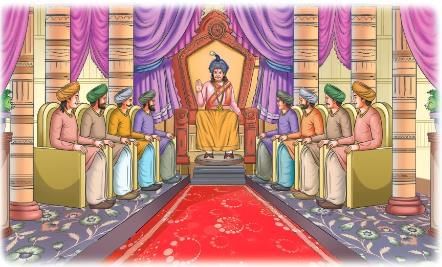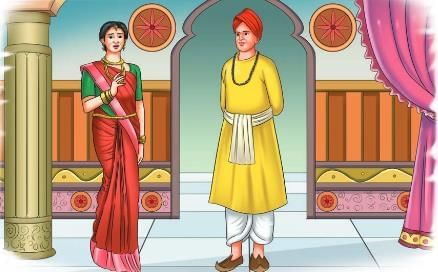Very Short Answer Questions: The Wit that Won Hearts | English Poorvi Class 8 - New NCERT PDF Download
Q1. Who was the ruler of the Vijayanagara Empire during its Golden Era?
Ans: Krishnadeva Raya was the ruler during the Golden Era.
Q2. What was the name of Krishnadeva Raya’s epic poem?
Ans: His epic poem was Amuktamalyada.
Q3. What was the name of the Sanskrit play written by Krishnadeva Raya?
Ans: The Sanskrit play was Jambavati Parinayam.
Q4. How many esteemed poets were part of the Ashtadiggajas?
Ans: There were eight esteemed poets in the Ashtadiggajas.
Q5. Who was one of the famous poets in Krishnadeva Raya’s court known for his wit?
Ans: Tenali Ramakrishna was a famous poet known for his wit.
Q6. What caused the quarrel between Krishnadeva Raya and Thirumalambal?
Ans: The quarrel began when Thirumalambal yawned during the king’s poem recitation.
Q7. How did the palace atmosphere change after the king’s quarrel with the queen?
Ans: The palace became silent and somber.
Q8. Who did Thirumalambal approach for help to resolve the quarrel?
Ans: She approached Tenali Ramakrishna for help.
Q9. What did Tenali Rama ask the queen for before helping her?
Ans: He asked for time to devise a strategy.
Q10. What was the setting of the royal court when Tenali presented his plan?
Ans: The court was buzzing with ministers and scholars discussing paddy cultivation.
Q11. What did Tenali Rama hold while addressing the king in court?
Ans: He held a plate of paddy seeds.
Q12. What did Tenali claim about the paddy seeds he presented?
Ans: He claimed they could yield three times more than the current harvest.
Q13. How did the courtiers initially react to Tenali’s claim about the seeds?
Ans: They reacted with sarcasm and snickers.
Q14. What did the king say was necessary for a higher crop yield?
Ans: He said special soil and pest control were necessary.
Q15. What did Tenali say was the real issue affecting the harvest?
Ans: He said the real issue was the sower, not the seeds.
Q16. What natural action did Tenali compare yawning to in court?
Ans: He compared yawning to breathing.
Q17. What did the king realize after Tenali’s words in court?
Ans: He realized he had misjudged Thirumalambal for yawning.
Q18. What did Krishnadeva Raya do after reflecting on his mistake?
Ans: He apologized to Thirumalambal.
Q19. How did Thirumalambal respond to the king’s apology?
Ans: She smiled and asked to hear his poem.
Q20. What was the outcome of Tenali’s tactic in the palace?
Ans: It restored harmony, and joy and laughter returned to the palace.
|
59 videos|434 docs|57 tests
|
FAQs on Very Short Answer Questions: The Wit that Won Hearts - English Poorvi Class 8 - New NCERT
| 1. What is the central theme of "The Wit that Won Hearts"? |  |
| 2. Who are some notable figures associated with wit in history mentioned in the article? |  |
| 3. How does the article illustrate the impact of wit on communication? |  |
| 4. What lessons can be learned from the examples of wit in the article? |  |
| 5. Why is wit considered a valuable trait in personal and professional relationships? |  |

















